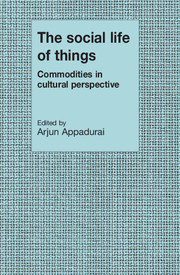Book contents
- Frontmatter
- Contents
- Contributors
- Foreword
- Preface
- Part I Toward an anthropology of thing
- Part II Exchange, consumption, and display
- Part III Prestige, commemoration, and value
- Part IV Production regimes and the sociology of demand
- Part V Historical transformations and commodity codes
- 9 The structure of a cultural crisis: thinking about cloth in France before and after the Revolution
- 10 The origins of swadeshi (home industry): cloth and Indian society, 1700–1930
- Index
9 - The structure of a cultural crisis: thinking about cloth in France before and after the Revolution
Published online by Cambridge University Press: 05 June 2014
- Frontmatter
- Contents
- Contributors
- Foreword
- Preface
- Part I Toward an anthropology of thing
- Part II Exchange, consumption, and display
- Part III Prestige, commemoration, and value
- Part IV Production regimes and the sociology of demand
- Part V Historical transformations and commodity codes
- 9 The structure of a cultural crisis: thinking about cloth in France before and after the Revolution
- 10 The origins of swadeshi (home industry): cloth and Indian society, 1700–1930
- Index
Summary
The great French Revolution of 1789–99 brought a general change in the way French people thought about commodities. This change occurred within a society that had centuries of experience with money-based exchange behind it, and one that, although undergoing rapid commercial expansion in the eighteenth century, saw no significant change in the predominant modes of production either before, during, or after the crisis. Industrial capitalism was all but nonexistent in France in 1789 and still quite exceptional in 1815. Yet millions of French people in the interim adopted what could only be called a capitalist mode of evaluating commodities. It is the object of this essay to show that this involved a change in the generally accepted notions of what a commodity was. This is a properly modest goal, made more modest by the concentration on a single kind of commodity, albeit an essential one, cloth. But even in pursuing this modest goal, one is forced to recognize that political institutions, the social hierarchy, the day-to-day relationships between persons at street level, and the far-flung workings of ideological control and commercial dependence all had to undergo significant reconstruction in conjunction with this shift in thought about commodities. (No suggestion about priority is implied here.)
- Type
- Chapter
- Information
- The Social Life of ThingsCommodities in Cultural Perspective, pp. 261 - 284Publisher: Cambridge University PressPrint publication year: 1986
- 16
- Cited by



